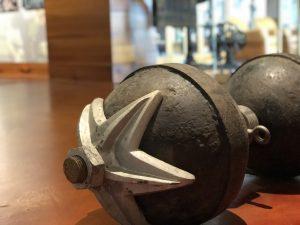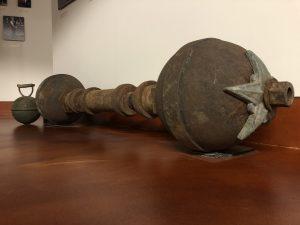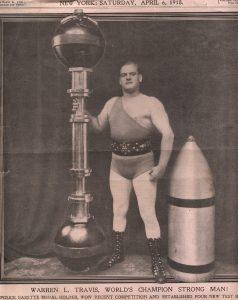Warren Lincoln Travis began his strongman career as the “Brooklyn Strong Boy,” but quickly graduated to circuses and vaudeville and also worked long stints at Coney Island. Travis was America’s most famous strongman in the early years of the twentieth century. Most other touring professionals of the era were Europeans or Canadians – Sandow, the Saxon Trio, Apollon, Louis Cyr, and Horace Barre. To distinguish himself from these other contemporaries, Travis’ performances were marked by the lifting of monstrous amounts of weight in back lifts, in hip and harness lifts, and in the crowd-pleasing one-finger lift (a note from Stark Center founder Terry Todd states Travis “had hands which, though small, were capable of amazing feats”). Although Travis also lifted barbells and dumbbells overhead and could curl a dumbbell with the best of them, he was famous for his willingness to lift truly heavy weights in these less-elegant, but impressive lifts.
Travis was particularly famous for his backlifting, and often finished his show by putting a dozen or more men on a platform, then crawling under it and lifting it by pushing with his back and straightening his knees. He also lifted heavy blocks and kettlebells, sometimes with his teeth, using a towel pulled through the handle as a place to get a grip (or bite). When it came to implements of iron, he was a savvy enough showman to know his stage weights needed to be massive in size and compelling to the eye. Here at the H.J. Lutcher Stark Center, we have on display a barbell and a dumbbell, both made to Travis’ specifications, both used in his professional strongman performances. The weights are remarkably elaborate and feature matching star-shaped clamps on the end of either bell.
The “dumbbell,” partially filled with lead, is fifty-two inches long and weighs 1560 pounds. Second only to the Farnese Hercules (10’ 6” tall), this is the single heaviest object that we have on display. A large eye-bolt, fixed through the central part of the dumbbell with an equally large nut, is where Travis would have hooked himself to the weight via a leather harness fitted around his waist and shoulders, which allowed him to raise the dumbbell off the ground. Each bell has a circumference greater than fifty inches. I have watched many visitors squat down in front of the dumbbell to admire its size and detail. They stand up, aghast. “Someone actually lifted this thing?”
The barbell, by contrast, is nearly seven feet long and weighs 330 pounds – a relatively light weight in comparison to its partner, the dumbbell; however, no less impressive to lift. This is because, in order to lift, it requires great grip strength due to the circumference of the bar and the designated spaces where you have to grip the bar. These spaces are only three inches wide. For scale, my hands have never been called, “mighty mitts,” but my fist measures more than four inches wide. Adding to the difficulty, the bar measure nine inches in circumference. My hand measures only seven and one quarter inches from the base of my palm to the tip of my middle finger. There’s no easy or obvious approach on how to hold the bar for a real lift. This might by why there are so few photos showing anyone lifting the bar overhead.
These gargantuan tools of the iron game began their journey to The Stark Center in Brooklyn, New York when Warren Lincoln Travis sold them (and other items) to “Professor” Harry Shafran, who operated gyms in both New York City and Brooklyn. Shafran eventually hauled his heavy trove to northern Pennsylvania, where he converted part of an old wooden barn into a training facility and ran it as a gym. After his death in 1975, Shafran’s widow closed the gym, and eventually sold the entire property, barbells and all. Nearly forty years later, Jan Todd discovered two items listed on Ebay that piqued her interest. The barbells that once belonged to Warren Lincoln Travis had been thought missing for many years. She and Terry Todd followed the thread and her original Ebay discovery led to the acquisition of these and more Warren Lincoln Travis artifacts during a road trip that also included a stop in Johnson City, Tennessee at the former home of Bob Peoples. The story of this important trip in the first year of the Center’s founding is masterfully retold in Terry Todd’s blog titled, “There and Back Again,” the snowy saga of a three-quarter ton extended cab pickup truck.






Leave a Reply